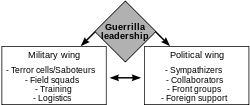Unconventional warfare
| Part of a series on |
| War Outline |
|---|
 |
Unconventional warfare (UW) is the support of a foreign insurgency or resistance movement against its government or an occupying power. One of the first references is in "Manpower and Atomic War," [1] which Edward Fitzpatrick referred to as "the next kind of war- technological war, machine war, or atomic war."
Whereas conventional warfare is used to reduce the opponent's military capability directly through attacks and maneuvers, unconventional warfare is an attempt to achieve victory indirectly through a proxy force. UW contrasts with conventional warfare in that forces are often covert or not well-defined and it relies heavily on subversion and guerrilla warfare.
Objectives
As with all forms of warfare, unconventional warfare's general objective is to instill a belief that peace and security are not possible without compromise or concession. Two original definitions are claiming: "The intent of U.S. Unconventional Warfare efforts is to exploit a hostile power’s political, military, economic, and psychological vulnerabilities by developing and sustaining resistance forces to accomplish U.S. strategic objectives." or according to John F. Kennedy: "There is another type of warfare—new in its intensity, ancient in its origin—war by guerrillas, subversives, insurgents, assassins; war by ambush instead of by combat, by infiltration instead of aggression, seeking victory by eroding and exhausting the enemy instead of engaging him. It preys on unrest."[2]
Unconventional warfare can be employed in the furtherance of one of three strategic outcomes: Overthrow of an existing government or occupying power, disruption of the operations of that power, or the coercion of that power.
Methods and organization
Unconventional warfare targets the civilian population psychologically to win hearts and minds, and only targets military and political bodies for that purpose, seeking to render the military proficiency of the enemy irrelevant. Limited conventional warfare tactics can be used unconventionally to demonstrate might and power, rather than to reduce the enemy's ability to fight substantially. In addition to the surgical application of traditional weapons, other armaments that specifically target the military can be used are: airstrikes, nuclear weapons, incendiary devices, or other such weapons.
Special Forces, inserted deep behind enemy lines, are used unconventionally to train, equip, and advise locals who oppose their government. They can also spread subversion and propaganda, while they aid native resistance fighters, to ultimately cause a hostile government to capitulate. Tactics focus on destroying military targets while avoiding damage to civilian infrastructure and blockading military resupply are used to decrease the morale of government forces.[3]

The USA Department of Defense defines unconventional warfare as activities conducted to enable a resistance movement or insurgency to coerce, disrupt, or overthrow a government or occupying power by operating through or with an underground, auxiliary, and guerrilla force in a denied area. Also called UW.[4]
See also
- Asymmetric warfare
- Hybrid warfare
- Fourth generation warfare
- Irregular military
- Irregular warfare
- Low intensity conflict
- Partisan (military)
- Political warfare
- Psychological warfare
- Resistance movement
- Terrorism
- Unrestricted Warfare
- A seminal work on unconventional stay-behind warfare is Major Hans von Dach's Der Totale Widerstand (Total Resistance).
- Six-legged Soldiers - A scientific warfare book on another potential form of unconventional warfare, by Jeffrey A. Lockwood
US & NATO specific:
- Operation Gladio
- Project Eldest Son
- Reagan Doctrine
- Special Activities Division
- U.S. Army Special Forces
References
- ^ Fitzpatrick, Edward A. (1951), Manpower and Atomic War, vol. 278.1, The Annals of the American Academy of Political and Social Science, p. 126-136;
{{citation}}: CS1 maint: extra punctuation (link) Also see: United States, President's Advisory Commission on Universal Training (29 May 1947), A program for national security, Washington, U.S. Govt. Print. Off., p. 14,Second, and equal in importance to the first, we must have trained men in every part of our own country ready and able to meet disorder, sabotage, and even invasion.
- ^ "U.S. Army Special Forces Unconventional Warfare Training Manual November 2010". U.S. ARMY. March 3, 2011.
- ^ Kitzen M. (2020) Operations in Irregular Warfare. In: Sookermany A. (eds) Handbook of Military Sciences. p. 1-21. Springer, Cham doi:10.1007/978-3-030-02866-4_81-1
- ^ "Department of Defense Dictionary of Military and Associated Terms" (PDF). pp. JP 1-02. Retrieved 25 June 2019.
External links
- Insurgency Research Group – Multi-expert blog dedicated to the study of insurgency and the development of counter-insurgency policy.
- Allied war terminology (File #5a)
- goarmy.com/special_forces/unconventional_warfare
- [permanent dead link] Unconventional Warfare: Definitions from 1950 to the Present [dead link]
- Unconventional Warfare: A Better Path to Regime Change in the Twenty First Century
- Instruments of Statecraft: U.S. Guerrilla Warfare, Counterinsurgency, and Counterterrorism, 1940–1990
- Pentagon plans cyber-insect army
